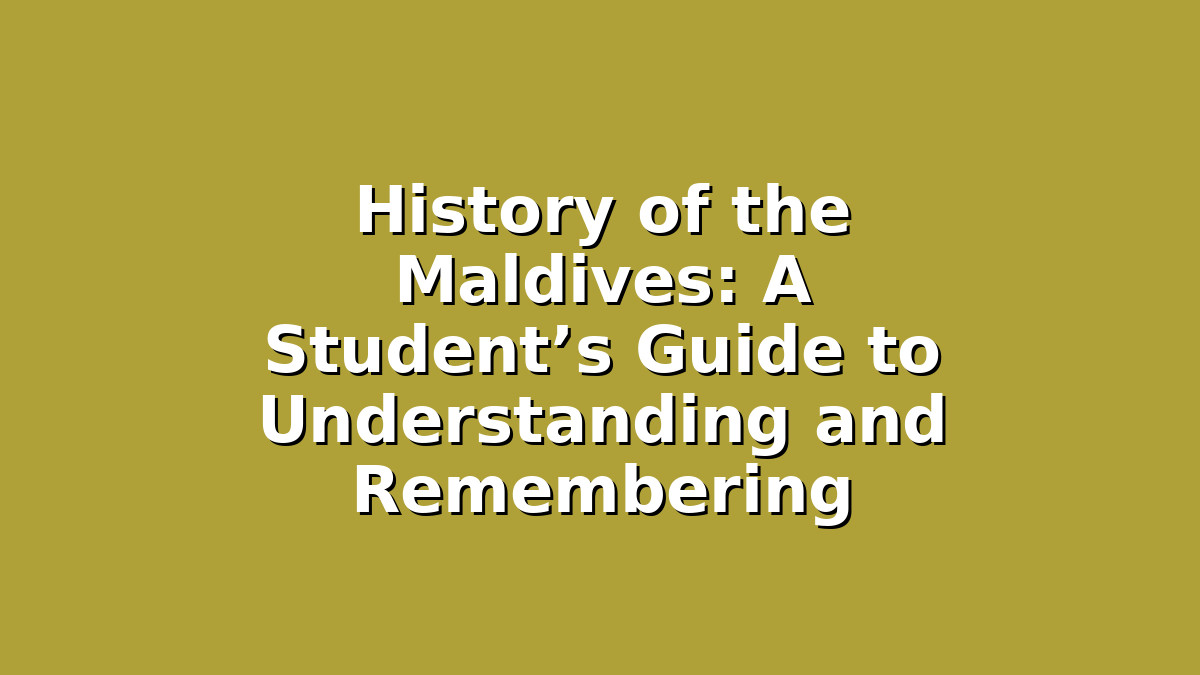The Maldives, an enchanting island nation in the Indian Ocean, is known worldwide for its stunning beaches and crystal-clear waters. But beyond its natural beauty lies a rich and fascinating history that is worth exploring, especially for students preparing for exams or anyone interested in learning more about this unique country. Understanding the history of the Maldives can be a fun and rewarding experience if approached with the right strategies. In this article, we will delve into the history of the Maldives and provide helpful study tips to make your learning journey smooth and effective.
Introduction
History can sometimes feel overwhelming due to the abundance of dates, names, and events. However, focusing on the Maldives gives you a manageable topic that combines geography, culture, and political change — all crucial elements in your exams. Whether you are studying for a history test, preparing for a geography assignment, or just want to improve your study habits, this article will guide you through the Maldives’ historical timeline and share practical advice to help you retain information better.
—
1. Ancient Origins and Early Settlements: How to Build a Strong Foundation
The Maldives’ history begins thousands of years ago. Archaeological evidence suggests that the islands were initially settled by people from the Indian subcontinent and possibly Sri Lanka around 500 BCE. Early inhabitants were likely involved in fishing, seafaring, and trading, which shaped much of the islanders’ culture.
The Maldives is mentioned in ancient Indian and Arab chronicles, indicating its importance as a stopover for traders navigating the Indian Ocean. For centuries, the islands remained a small but strategic hub for commerce between Asia, Africa, and the Middle East.
Study Tip:
When studying ancient history, it helps to create timelines or flowcharts. For example, jot down key points about early settlements, the origin of the people, and trade relations. Visual tools like these help you understand cause and effect and make it easier to recall facts during exams. Also, try associating dates or events with stories or vivid images to anchor the information in your memory.
—
2. The Islamic Era and Sultans: Connecting Culture and Politics
Around the 12th century CE, the Maldives underwent a significant transformation with the introduction of Islam. According to tradition, the conversion was led by a Muslim visitor named Abu al-Barakat, who convinced the Maldivian king to embrace Islam. This event marked the beginning of the Maldives’ long history as an Islamic sultanate.
Over the centuries, the Maldives was ruled by various sultans, who governed the islands through a system influenced by Islamic law and culture. The sultans maintained relative independence but also faced challenges from foreign powers interested in the strategic location and resources of the Maldives.
During this period, the Maldives became a center of Islamic scholarship and culture in the region, with mosques and madrassas being built throughout the islands.
Study Tip:
When studying political or cultural history, try to connect the information to the broader story. Ask yourself questions like: Why was the introduction of Islam important? How did it change the Maldives? Creating “story maps” where you link events to cultural shifts or political changes can deepen your understanding. Additionally, teaching this story to a friend or family member can reinforce your grasp and boost your confidence.
—
3. Colonial Influence and Modern Independence: Preparing for Exam Essays
In the 16th century, the Maldives experienced European influence, particularly from the Portuguese, Dutch, and later the British. While the islands were never formally colonized, the British established a protectorate over the Maldives in 1887. This arrangement lasted until 1965 when the Maldives gained full independence.
The British protectorate period introduced new administrative structures and connected the Maldives more closely with the global political scene. After independence, the Maldives transitioned to a republic and embarked on modernization efforts, balancing tradition with new economic and social developments.
Today, the Maldives is a peaceful nation known for its vibrant culture, tourism, and efforts to address climate change.
Study Tip:
Longer essay questions often focus on causes and effects or comparisons (e.g., pre- and post-independence). Practice outlining essays by dividing them into introduction, body, and conclusion. Write bullet points for each paragraph, summarizing the key arguments. This method helps you organize your thoughts clearly and saves time during exams. Also, reviewing past exam questions and practicing writing answers under timed conditions can improve both your writing skills and exam performance.
—
Conclusion
The history of the Maldives is a captivating journey through ancient settlements, the spread of Islam, and the path to modern independence. For students, breaking down this history into manageable sections and using effective study techniques can make a significant difference. Remember to use timelines, story maps, and essay outlines to organize your knowledge and boost your confidence.
Most importantly, stay curious and patient as you learn. History is not just about memorizing facts; it’s about understanding the stories and people behind those facts. With the right approach, studying the Maldives’ history can be a rewarding experience that not only helps you excel in exams but also enriches your appreciation of this beautiful island nation.
Good luck with your studies!
—

Responses